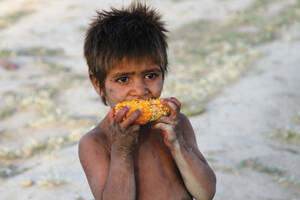While government corruption, NATO air strikes gone awry and brutal attacks by Taliban insurgents gather the most headlines, another crisis of major proportions is stalking Afghanistan. After a third year of drought and significant cutbacks in resources from the United Nations World Food Program, hunger may place as many as 1.5 to 2 million people in northern and western Afghanistan at risk of starvation this fall. That is in addition, reports the U.N., to 7.3 million around the country who already live under conditions of famine.
The most vulnerable households are rapidly using up food reserves. An estimated 73 percent of the population in affected areas say that they will have access to food for less than two months. The hunger crisis is expected to last until the end of next year’s harvest in August 2012. And according to humanitarian agencies working in Afghanistan, hunger is not the only concern. The few water resources that have not dried up are often contaminated, which leads to heightened risk of disease. Outbreaks of acute diarrhea have been reported across the country, a mild illness in the West but potentially fatal among malnourished Afghan children.
In a normal year, Afghanistan produces 4.5 million tons of wheat and imports another million. The drought has led to a decrease of almost 1.9 million tons of wheat this year. That means much more wheat must be secured from other sources during a period of historically high commodity prices. The high food prices, crop reductions and funding cuts for food programs planned for 2012 is likely to create growing food scarcity in often inaccessible villages.
“The areas affected by drought are hard or impossible to reach by road during the winter,” said the food program’s spokesperson, Assadullah Azhari. “So it is critical to get food assistance in place early, before those people are cut off by snowfall.”
Because of a significant funding shortfall, the W.F.P. plans to cut its programs in nearly half of Afghanistan’s 34 provinces. According to the W.F.P., the United States has reduced its funding of the food program’s activities in Afghanistan by more than two-thirds since 2009. “But we continue to appeal to donors for the support that will allow us to ensure all those in need of help in the coming months are assisted,” said Azhari.
W.F.P. estimates that it would take $200 million to reach the full seven million Afghans it hopes to assist; at present it is reaching only 3.8 million. “We are having to refocus our activities to continue supporting those who are most in need, especially in provinces that have the largest number of people who are either very highly food insecure or very food insecure,” a W.F.P. spokesperson, Challiss McDonough, said. “We will also continue school feeding in the south because of the role it plays in getting children, especially girls, to enroll and attend school.”
After 10 years of conflict since the ouster of the Taliban in 2001, Afghanistan frequently tops the list of nations that face the risk of food shortages and hunger effects on children. In addition to climate extremes like drought and flooding, crop production in Afghanistan is troubled by ongoing violence and unique problems like the need to clear fields of unexploded ordnance left behind by decades of conflict.








